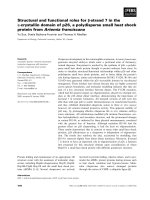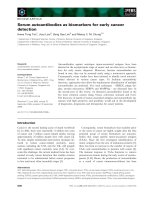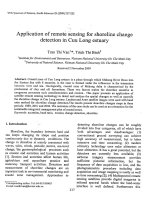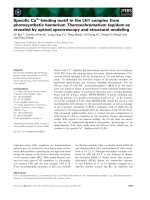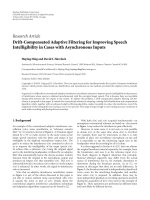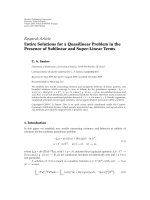Multimodal optical spectroscopy and imaging for improving cancer detection in the head and neck at endoscopy
Bạn đang xem bản rút gọn của tài liệu. Xem và tải ngay bản đầy đủ của tài liệu tại đây (4.85 MB, 145 trang )
MULTIMODAL OPTICAL SPECTROSCOPY AND
IMAGING FOR IMPROVING CANCER DETECTION IN
THE HEAD AND NECK AT ENDOSCOPY
LIN KAN
NATIONAL UNIVERSITY OF SINGAPORE
2012
MULTIMODAL OPTICAL SPECTROSCOPY AND IMAGING FOR IMPROVING
CANCER DETECTION IN THE HEAD AND NECK AT ENDOSCOPY LIN KAN 2012
MULTIMODAL OPTICAL SPECTROSCOPY AND
IMAGING FOR IMPROVING CANCER DETECTION IN
THE HEAD AND NECK AT ENDOSCOPY
LIN KAN
A THESIS SUBMITTED
FOR THE DEGREE OF DOCTOR OF PHILOSOPHY
DEPARTMENT OF BIOENGINEERING
NATIONAL UNIVERSITY OF SINGAPORE
2012
To my family and friends for their love, support and
encouragement
I
Acknowledgements
The research work presented in this thesis was primarily conducted in Optical
Bioimaging Laboratory in the Department of Bioengineering of National University
of Singapore during the period from January 2007 to January 2012. In the past 5 years,
I met many nice friends in this lab who gave me great encouragement and kind help.
Here I would like to thank them sincerely.
First and foremost, I would like to express my sincere appreciation to my
supervisor Professor Huang Zhiwei, who offered me the opportunity in the very
beginning to pursue the PhD degree in his group. I am indebted to Prof Huang for his
technical advice, professional guidance and patience throughout my PhD study. I
believe and appreciate that Prof Huang with his insightful view and high standard
requirements to the research has an extraordinary impact on my future research career.
I would also express my gratitude to Dr. David Lau from the Department of
Otolaryngology, Singapore General Hospital, who offered me invaluable support and
great patience in conducting the clinical trials. I would also like to acknowledge my
coworkers and team members in Optical Bioimaging Laboratory: Dr Zheng Wei, Dr
Yuen Clement, Dr Liu Linbo, Dr Kou Shanshan, Dr Lu Fake, Mo Jianhua, Teh Seng
Knoon, Dr Shao Xiaozhuo, Lin Jian, Mads Bergholt, Shiyamala Duraipandian, Dr
Zhang Qiang and Chen Ling for their kind discussions, suggestions and help on my
research work. I also wish to thank my dear parents and all my lovely friends in
Singapore, with whom I kept walking through these hard working days.
Last but not least, I also would like to acknowledge the financial support from
the Ministry of Education of Singapore, Biomedical Research Council, the National
Medical Research Council and the Faculty Research Fund from the National
II
University of Singapore (NUS) for this research.
LIN Kan
NUS, Singapore 2012
III
Table of Contents
Acknowledgements I
Table of Contents III
Abstract V
List of Figures VIII
List of Tables XII
List of Abbreviations XIII
Chapter 1 Introduction 1
1.1
Background 1
1.1.1
Head and neck cancers 2
1.1.2
Conventional cancer screening methods 4
1.1.3
Gold standard 10
1.1.4
Optical techniques for cancer diagnosis 11
1.2
Motivations and Research Objectives 16
1.3
Thesis Organization 17
Chapter 2 Overview of Spectroscopy and Endoscopic Imaging Techniques for
Cancer Diagnosis 19
2.1
Principles of Optical Spectroscopy and Imaging 19
2.1.1
Diffuse reflectance 20
2.1.2
Fluorescence 23
2.1.3
Raman scattering 28
2.2
Reviews of Optical Spectroscopy Techniques in Cancer Diagnosis 30
2.2.1
Diffuse reflectance spectroscopy 31
2.2.2
Autofluorescence spectroscopy 32
2.2.3
Raman spectroscopy 35
2.3
Multivariate Statistical Analysis Techniques for Tissue Classification 38
2.3.1
Principle component analysis (PCA) 39
2.3.2
Linear discriminant analysis (LDA) 40
2.3.3
Partial least squares (PLS) 40
2.3.4
Support vector machine (SVM) 41
2.3.5
Artificial neural network (ANN) 42
Chapter 3 Development of Simultaneous Point-wise AF/DR Spectroscopy and
Endoscopic Imaging Technique 43
3.1
Introduction 44
3.2
Integrated Point-wise DR/AF Spectroscopy and Imaging System 45
3.2.1
Novel point-wise AF/DR spectroscopy 45
IV
3.2.2
In vivo experimental measurement in the head and neck 49
3.3
Endoscopy based AF/DR Spectroscopy for Laryngeal Cancer Diagnosis 53
3.3.1
Subjects and tissue preparation 53
3.3.2
Combine AF/DR spectra for improving cancer diagnosis 54
3.3.3
Results and discussion 55
3.4
Conclusion 63
Chapter 4 Endoscope-based Fiber-optic Raman Spectroscopy for Characterizing
Raman Properties of Human Tissue in the Head and Neck 64
4.1
Introduction 65
4.2
Integrated Raman Spectroscopy at Endoscopy 66
4.2.1
Integrated Raman spectroscopy and endoscopic imaging system 66
4.2.2
Endoscope-based fiber optics Raman probe 68
4.2.3
Evaluation of in vivo tissue Raman measurement in the oral cavity 70
4.3
Characterization of Raman Spectral Properties in the Nasopharynx and
Larynx in vivo 72
4.3.1
Patients and procedure 73
4.3.2
Multivariate statistical analysis 74
4.3.3
Results and discussion 75
4.4
Conclusion 85
Chapter 5 High Wavenumber Raman Spectroscopy for Laryngeal Cancer
Diagnosis 87
5.1
Introduction 87
5.2
HW Raman Spectroscopy for Cancer Diagnosis 89
5.2.1
Raman endoscopic instrument 89
5.2.2
Subjects and procedures 91
5.3
Results 93
5.3.1
Tissue Raman spectra 93
5.3.2
Cancer diagnosis by using PCA-LDA 94
5.4
Discussion 97
5.5
Conclusion 99
Chapter 6 Conclusions and Future Directions 100
6.1
Conclusions 100
6.2
Future Directions 102
List of Publications 109
References 111
V
Abstract
Early diagnosis and localization of head and neck cancers with effective
treatment is critical to decreasing the mortality rates.
But identification of early cancer
can be difficult by using the conventional white-light reflectance (WLR) imaging
which heavily relies on visualization of tissue gross morphological changes associated
with neoplastic transformation. Optical spectroscopic techniques, such as
autofluorescence (AF) spectroscopy and diffuse reflectance (DR) spectroscopy, which
provide the information about tissue optical properties, morphologic structures,
endogenous fluorophore distribution, blood content and oxygenation, have been
comprehensively investigated for in vitro or in vivo precancer and cancer diagnosis
with high diagnostic sensitivity. Raman spectroscopy is an optical vibrational
technique capable of providing specific information about biochemical compositions
and structures of tissue, which has excelled in the early cancer detection with high
diagnostic specificity. This thesis work aims to develop a multimodal optical
spectroscopy and imaging technique to complement the WLR imaging for improving
cancer diagnosis and characterization at endoscopy.
We have developed an endoscope-based AF/DR spectroscopy and AF/WLR
imaging system for cancer detection in the head and neck. The point-wise AF/DR
spectra can be acquired in real-time from any specific area of the imaged tissue of
interest under the AF/WLR imaging guidance. Spectroscopic measurements of normal
(n = 207) and cancerous (n = 239) laryngeal tissue samples from 30 patients were
performed to evaluate the diagnostic utility of the combined AF/DR spectroscopy for
improving laryngeal cancer diagnosis. The composite AF and DR spectra in the range
of 500–660 nm were analyzed using principal component analysis (PCA) and linear
VI
discriminant analysis (LDA), which yielded a diagnostic accuracy of 94.8%
(sensitivity of 91.6% and specificity of 98.6%) for cancer detection.
We have also developed a miniaturized fiber-optic Raman endoscopy
technique for in vivo tissue Raman measurements in the head and neck. We carried
out the transnasal image-guided Raman endoscopy for the first time to directly assess
distinctive Raman spectral properties of nasopharyngeal and laryngeal tissues in vivo
during endoscopic examinations. A total of 874 high-quality in vivo Raman spectra
were successfully acquired from different anatomic locations of the nasopharynx and
larynx (i.e., posterior nasopharynx (PN) (n=521), the fossa of Rosenmüller (FOR)
(n=157), and true laryngeal vocal chords (LVC) (n=196)) in 23 normal subjects at
transnasal endoscopy. The PCA-LDA modeling provides a sensitivity of 77.0% and
specificity of 89.2% for differentiation between PN vs. FOR, and sensitivity of 67.3%
and specificity of 76.0% for distinguishing LVC vs. PN using leave-one subject out,
cross validation. We demonstrated that transnasal image-guided Raman endoscopy
can be used to acquire in vivo Raman spectra from the nasopharynx and larynx in
real-time. Significant Raman spectral differences (p<0.05) identified reflecting the
distinct composition and morphology in the nasopharynx and larynx should be
considered as an important parameter in the interpretation and rendering of diagnostic
decision algorithms for in vivo tissue diagnosis and characterization in the head and
neck.
Further, we also explored the utility of transnasal image-guided high
wavenumber (HW) Raman spectroscopy to differentiate tumor from normal laryngeal
tissue at endoscopy. A total of 94 HW Raman spectra (22 normal sites, 72 tumor sites)
were acquired from 39 patients who underwent laryngoscopic screening. Significant
differences in Raman intensities of prominent Raman bands at 2845, 2880 and 2920
VII
cm
-1
(CH
2
stretching of lipids), and 2940 cm
-1
(CH
3
stretching of proteins) were
observed between normal and cancer laryngeal tissue. PCA-LDA modeling on HW
Raman spectra yields a diagnostic sensitivity of 90.3% and specificity of 90.9% for
laryngeal cancer identification.
The results of this thesis work suggest that the unique image-guided
multimodal (AF/DR/Raman) spectroscopy technique developed has great potential for
improving in vivo diagnosis and detection of cancer in the head and neck during
clinical endoscopic examination.
VIII
List of Figures
Fig. 1.1
Long term trends in cancer incidence and death rates (1975-2006).…… 2
Fig. 1.2
Overview of Head and neck cancer regions.…………………………… 3
Fig. 2.1
Interactions between tissue and light……………………………………20
Fig. 2.2
Absorption spectra of oxy- and deoxyhemoglobin in the ranges 450-1000
nm (left), and 650-1050 nm (right) ………………… ………22
Fig. 2.3
Absorption spectrum of water in the ranges 200-1000 nm (left) and an
expended scale from 650-1050nm (right)… 23
Fig. 2.4
Energy diagram showing absorption and emission transitions between
vibrational sublevels in ground and electronically excited states………24
Fig. 2.5
Excitation (A) and emission spectra (B) of the principal endogenous
fluorophores 27
Fig. 2.6
Energy level diagram showing the states involved in Raman signal. The
line thickness is roughly proportional to the signal strength from the
different transitions……………………………………………………29
Fig. 3.1
Schematic of the inte grated point-wis e spect roscop y a nd
autofluorescence (AF) imaging system for in vivo tissue measurements at
endoscopy…………………………….…………………………………47
Video 3.1
Video illustrating simultaneous AF imaging and point-wise AF spectral in
vivo measurements of the cheek in real-time during AF endoscopic
imaging [URL: …….…………48
Fig. 3.2
In vivo white-light images and the corresponding diffuse reflectance (DR)
spectra from different anatomical locations (chin, buccal mucosa, dorsal
of the tongue, and lower lip) simultaneously acquired from a healthy
volunteer……… ……………………………………………………….50
Fig. 3.3
Comparison of in vivo AF images and the corresponding point-wise AF
spectra from different anatomical locations (chin, buccal mucosa, dorsal
of the tongue, and lower lip) simultaneously acquired from a healthy
volunteer. Note that each DR spectrum is acquired within 10 ms, whereas
the AF spectrum is acquired within 0.1s……………….…… ….….….51
Fig. 3.4
Comparison of in vivo AF spectra of different sites of the cheek on the AF
endoscopic image simultaneously acquired from a healthy volunteer.…52
Fig. 3.5
AF intensity profiles along the line indicated on the autofluorescence
image acquired from the cheek: (I) Distribution of the endogenous
fluorophore-flavins (autofluorescence peaking at 535 nm). (II)
Distribution of the endogenous fluorophore–protoporphyrin
(autofluorescence peaking at 630 nm).….………………………………52
Fig. 3.6
Representative examples of (a) AF images and (b) WLR images of
laryngeal tissue specimens (upper normal, lower tumor) using blue
IX
light/white light as excitation……………………………….………… 56
Fig. 3.7
Comparison of mean spectra ±1 standard deviations (SD) and normalized
spectra of normal (n=207) and tumor (n=239) laryngeal tissues. (a) mean
AF spectra ±1 SD; (b) normalized AF spectra; (c) mean DR spectra ±1
SD; (d) normalized DR spectra; (e) mean IF spectra ±1 SD; (f)
normalized IF spectra; The shaded area represents the respective standard
deviations.…….…………………………………………………………57
Fig. 3.8
The three significant principal components (PCs) accounting for more
than 90% of the total variance calculated from AF/DR/IF spectra of
laryngeal tissue. The significant PCs loadings of (a) AF spectra (PC1:
85.1%; PC3: 1.41%; PC4: 0.62%), (b) DR spectra (PC1: 97.4%; PC3:
0.66%, PC4: 0.13%) and (c) IF spectra (PC1: 92.5%, PC3: 0.60%, PC7:
0.04%)) is shown respectively. Note that the PCs loading curves was
shifted vertically for better visualization…………… …………………59
Fig. 3.9
Scatter plot of the posterior probability values belonging to the normal
and cancerous tissue categories calculated from (a) AF, (b) DR and (c)
combined AF/DR spectra, respectively, using the PCA-LDA technique
together with leave-one-site-out, cross-validation method. The dashed
line gives the sensitivities of 84.2% (101/120), 76.7% (92/120), and 85%
(102/120); specificities of 78.9% (281/356), 73.3% (261/356), and 81.7%
(291/356), respectively, for discriminating cancer from the normal
laryngeal tissues.………………………………………………… ……60
Fig. 3.10
Receiver operating characteristic (ROC) curves of discrimination results
for AF, DR and combined AF/DR spectra, respectively, for cancer tissue
classification through the use of point-wise AF/DR spectroscopy and
PCA-LDA diagnostic algorithms. The integrated area under curves
(AUC) are 0.979, 0.978 and 0.982 for the AF, DR and combined AF/DR
spectra, respectively, illustrating the best performance of integrated point-
wise AF/DR spectroscopy for laryngeal cancer diagnosis……… ……61
Fig. 4.1
Schematic of the integrated Raman spectroscopy and trimodal endoscopic
imaging system for in vivo tissue Raman measurements at endoscopy.
WLR, white light reflectance imaging; AFI, autofluorescence imaging;
NBI, narrow band imaging.………………………… …………………68
Fig. 4.2
Comparison of in vivo Raman spectra of buccal mucosa acquired from a
healthy volunteer under different Raman acquisition times (t = 0.1, 0.5
and 1.0 s). Each spectrum is normalized to its own acquisition
time.……………………………………………………………………71
Fig. 4.3
Comparison of in vivo Raman spectra of buccal mucosa acquired from a
healthy volunteer under three different wide-field imaging (i.e., WLR,
NBI, and AFI) illumination conditions. All spectra are normalized to
Raman acquisition times of 1.0s.…………….….………………………72
Fig. 4.4
Representative in vivo raw Raman spectrum acquired from the Fossa of
X
Rosenmüller with 0.1 s during clinical endoscopic examination. Inset of
Fig.4.4 is the processed tissue Raman spectrum after removing the
intense autofluorescence background.……………… …………………75
Fig. 4.5
In vivo (inter-subject) mean Raman spectra
± 1
standard deviations (SD)
of posterior nasopharynx (PN) (n=521), fossa of Rosenmüller (FOR)
(n=157) and laryngeal vocal chords (LVC) (n=196). Note that the mean
Raman spectra are vertically displaced for better visualization. In vivo
fiber-optic Raman endoscopic acquisitions from posterior nasopharynx
(upper) fossa of Rosenmüller (mid) and laryngeal vocal chords (lower)
under white light reflectance (WLR) and narrowband (NB) imaging
guidance are also shown. ……………….………………………………76
Fig. 4.6
In vivo (intra-subject) mean Raman spectra
± 1
SD of PN (n=18), FOR
(n=18) and LVC (n=17). Note that the mean Raman spectra are vertically
displaced for better visualization.………….……………………………77
Fig. 4.7
Comparison of difference spectra
± 1
SD of different anatomical tissue
types (inter- subject): [posterior nasopharynx (PN) – laryngeal vocal
chords (LVC)]; [posterior nasopharynx (PN) – fossa of Rosenmüller
(FOR)] and [laryngeal vocal chords (LVC) – fossa of Rosenmüller
(FOR)].……………………………….…………………………………78
Fig. 4.8
In vitro Raman spectra of possible confounding factors from human body
fluids (nasal mucus, saliva and blood).…………………………………79
Fig. 4.9
PC loadings resolving the biomolecular variations among different tissues
in the head and neck, representing a total of 57.41% (PC1: 22.86%; PC2:
16.16%; PC3: 8.13%; PC4 6.22% PC5: 4.04%) of the spectral
variance.………………… ……………………………………………80
Fig. 4.10
Box charts of the 5 PCA scores for the different tissue types (i.e., PN,
FOR and LVC). The line within each notch box represents the median,
but the lower and upper boundaries of the box indicate first (25.0%
percentile) and third (75.0% percentile) quartiles, respectively. Error bars
(whiskers) represent the 1.5-fold interquartile range. The p-values are
also given among different tissue types……….……….… ……………81
Fig. 5.1
Schematic of the integrated Raman spectroscopy and trimodal endoscopic
imaging system with software GUI (lower left) developed for in vivo
tissue Raman measurements in larynx …… …………………………90
Fig. 5.2
(A) Comparison of the mean HW Raman spectra ±1 standard deviations
(SD) of normal (n=22) and cancer (n=72) laryngeal tissue. (B) Difference
spectrum ±1 SD between cancer (n=72) and normal laryngeal tissue
(n=22). Note that the mean normalized HW Raman spectrum of normal
tissue was shifted vertically for better visualization (panel A); the shaded
areas indicate the respective standard deviations. The picture shown is the
Raman acquisitions from the larynx using endoscopic fiber-optic Raman
probe.……………………………………………………………………93
XI
Fig. 5.3
The first five principal components (PCs) accounting for about 99.2% of
the total variance calculated from HW Raman spectra of laryngeal tissue
(PC1=89.1%; PC2=7.41%; PC3=1.52%; PC4=1.08%; PC5=0.07%)….95
Fig. 5.4
Scatter plot of the linear discriminant scores for the normal and cancer
categories using the PCA-LDA method together with leave-one subject-
out, cross-validation method. The algorithm yields a diagnostic
sensitivity of 90.3% and specificity of 90.9% for differentiation between
normal and tumor tissues.……………….………………………………96
Fig. 5.5
ROC curve of discrimination results for Raman spectra utilizing the
PCA-LDA-based spectral classification with leave-one subject-out, cross
validation. The integration area under the ROC curves is 0.97 for PCA-
LDA-based diagnostic algorithm.………………………………………96
Fig. 6.1
(a) Schematic of the beveled fiber-optic confocal Raman probe coupled
with a ball lens for in vivo tissue Raman measurements at endoscopy; (b)
Comparison of the calculated and measured Raman collection
efficiencies (normalized to maximum) as a function of the gap distance d
between the fiber tip to the ball lens (left y-axis). The blue colored curve
in Fig 1b is the calculated Raman collection efficiency from the shallow
epithelium (within 150 µm) with respective to the total Raman emission
in two-layered buccal tissue (right y-axis); (c) The depth-resolved
distribution of Raman photons collected in two-layered tissue model 104
Fig. 6.2
(a) Comparison of mean in vivo raw spectra (Raman superimposed on
AF) acquired from the distal esophagus using the confocal Raman probe
(n=7) and volume-typed Raman probe (n=7) with 0.5 s integration time.
The blue colored curve is the ratio spectrum (i.e., the confocal Raman
spectrum divided by the Raman spectrum acquired by volume-typed
Raman probe). (b) Comparison of AF background-subtracted tissue
Raman spectra acquired by confocal and volume-typed Raman
probes.………………………………………………………… …… 105
Fig. 6.3
Bar diagrams
±
1 standard deviations (SD) showing the Raman to AF
ratios of different internal organs and anatomical tissue sites (i.e., buccal,
ventral tongue, distal esophagus and gastric) using confocal and volume-
typed Raman probes……………………………………………… ….106
XII
List of Tables
Table 3.1
Comparison of diagnostic performance of different spectral techniques
(AF, DR and the combined AF/DR) for discrimination of cancer from
normal laryngeal tissue……… …………………………………………60
Table 4.1
Tentative assignments of molecule vibrations and biochemicals involved
in Raman scattering of nasopharyngeal and laryngeal tissue……………77
XIII
List of Abbreviations
AF Autofluorescence
AFI Autofluorescence imaging
AFS Autofluorescence spectroscopy
AJCC American Joint Committee on Cancer
ANN Artificial neural network
ANOVA Analysis of variance
AOI Area of interest
CARS Coherent anti-stokes Raman scattering
CCD Charge coupled device
cLSM Confocal laser scanning microscopy
CT Computed tomography
DR Diffuse reflectance
DRS Diffuse reflectance spectroscopy
DST Dorsal side of the tongue
FAD Flavin adenine dinucleotide
FMN Flavin mononucleotide
FOR Fossa of Rosenmüller
FWHM Full width of half maximum
GI Gastrointestinal
HNC Head and neck cancer
HNSCC head and neck squamous cell carcinoma
HPV Human papillomavirus
HW High wavenumber
IR Infrared
IRB Institutional Review Board
LDA Linear discriminate analysis
LIFS Laser-induced fluorescence spectroscopy
LP Long-pass
LVs Latent variables
LVC Laryngeal vocal cords
MC Monte Carlo
MRI Magnetic resonance imaging
XIV
NADH Nicotinamide adenine dinucleotide
NB Narrow band
NBI Narrow band imaging
NHG National Healthcare Group
NLO Non-linear optical
NIR Near infrared
OCT Optical coherent tomography
OPSCC Oropharyngeal squamous cell cancer
OS Optical spectroscopy
PCs Principal components
PCA Principal components analysis
PET Positron emission tomography
PLS-DA Partial least square – discriminant analysis
RF Radio frequency
PN Posterior nasopharynx
RGB Red-green-blue
ROC Receiver operating characteristic
RS Raman spectroscopy
SCC Squamous cell carcinomas
SD Standard deviation
SE Standard error
SHG Second harmonic generation
SNR Signal-to-noise ratio
SRS Stimulated Raman scattering
SVM Support vector machine
THG Third harmonic generation
TNM Tumor-nodes-metastasis
UV Ultraviolet
VB Vermilion border
VIS Visible
VR Vibrational relaxation
WLE White light endoscopy
WLR White-light reflectance
1
Chapter 1 Introduction
1
1.1 Background
2
Cancer continues to be a major health threat to human beings in both
3
developed and developing countries over the world. One of most remarkable features
4
is the proliferative ability which makes the cancerous cells spread and invade distant
5
sites of human body after a certain stage of development. The tumor cells can invade
6
and destroy the adjacent tissues, even spread to other locations in the body through
7
lymph or blood. Compared to the malignant tumors, benign tumors do not invade or
8
metastasize in the tissue and they are more manageable with a higher rate of success.
9
Hence, early cancer detection and diagnosis with effective treatments is crucial to
10
reducing mortality rates of patients at a high risk of cancer. According to the cancer
11
statistics 2010, more than 562,875 cancer deaths were reported in United States in
12
2007, and more than 1.5 million new cancer cases are expected to be diagnosed [1].
13
Figure 1.1 depicts the long-term trends in cancer incidence and death rates for
14
all cancers by sex. Death rates for all cancer sites combined decreased by 2.0% per
15
year in men from 2001 to 2006 and by 1.5% per year in women from 2002 to 2006 [1].
16
The statistic evidence shows that mortality rates of cancer have continued to decrease
17
substantially, but cancer still accounts for about 23% of all deaths, ranking second
18
only to heart disease that is the leading cause of death among men and women ages 40
19
to 79 years [1]. In Singapore, a total number of 51,657 (48.6% males, 51.4% females)
20
incident cancer cases were diagnosed among the resident populations during the
21
period 2006-2010 [2]. The annual incidence rates for total male and female cancer
22
patients for the period 2006-2010 were 277.8 and 288.0 per 100,000 resident
23
populations, respectively. Cancer as a cause of death continued to increase in
24
2
importance over the last three decades [2].
1
2
Fig. 1.1 Long term trends in cancer incidence and death rates (1975-2006) [1].
3
4
1.1.1 Head and neck cancers
5
Head and neck cancers (HNCs) refer to a diverse group of biologically similar
6
malignancies and include upper aerodigestive tract (i.e., lip, mouth, tongue, throat,
7
larynx, etc.), salivary glands, nasal cavity, nasopharynx and lymph nodes in the neck
8
[3]. Other cancers occur in the brain, eye, esophagus and thyroid as well as those in
9
muscles and bones are usually not classified as HNCs. The figure 1.2 shows the
10
overview of the head and neck cancer (HNC) regions. Some common symptoms of
11
3
HNCs include a non-healing lump, a sore throat, trouble swallowing and a change or
1
hoarseness in the voice.
2
3
Fig. 1.2 Overview of Head and neck cancer (HNC) regions [4].
4
5
Around 40% cases of HNCs occur in the oral cavity which is a major sub-
6
group of HNCs, 25% in larynx, 15% in pharynx and the rest in the remaining sites
7
(e.g., salivary glands, thyroid) [5]. Histologically, more than 90% of all malignant
8
neoplasm of HNCs are squamous cell carcinomas (SCC) which originate from the
9
mucosal lining (epithelium) of these regions [3]. It usually spreads to the lymph nodes
10
of the neck, and this is often the first (and sometimes only) sign of the disease at the
11
time of diagnosis. HNCs are highly associated with certain environmental and
12
lifestyle risk factors, including tobacco smoking, alcohol consumption, ultraviolet
13
(UV) light irradiation, particular chemicals used in certain workplaces and certain
14
strains of viruses, such as human papillomavirus (HPV) [6, 7].
15
Approximately 500,000 new cancerous cases were confirmed as the head and
16
4
neck squamous cell carcinoma (HNSCC) per year, making HNSCC the 6th most
1
common cancer worldwide [6]. Particularly, HNSCC such as laryngeal and
2
nasopharyngeal cancers are diseases with high mortality rates [8]. In East Asia and
3
Africa, the rates of incidence and mortality due to nasopharyngeal carcinomas (NPC)
4
and laryngeal cancer are significantly higher than other parts of the world [9].
The 5-
5
year survival rate decreases significantly due to delayed diagnosis and NPC
6
symptoms generally present at late tumor-node-metastasis. Early identification and
7
adequate preoperative assessment of both nasopharyngeal carcinomas (NPC) and
8
laryngeal cancers allow functional preserving therapy (e.g., radiation therapy,
9
chemotherapy, surgery, etc.) and are also critical measures to reducing the mortality
10
rates of the patients. Yet, early diagnosis of nasopharyngeal and laryngeal precancer
11
and early cancer is clinically challenging even for experienced clinicians with the aid
12
of conventional white-light reflectance (WLR) endoscopy (e.g., microlaryngoscopy,
13
transnasal esophagoscopy) [10].
Moreover, positive identification of these lesions
14
highly relies on visualization of gross morphological manifestations that can be very
15
subjective. Therefore, it would be of imperative clinical value to develop a real-time
16
biomolecular sensitive optical diagnostic technology (‘optical biopsy’) that can assist
17
in the early detection of nasopharyngeal and laryngeal dysplasia and neoplasia during
18
transnasal endoscopic inspections.
19
1.1.2 Conventional cancer screening methods
20
Cancer diagnostic techniques developed for generating visual information (e.g.,
21
pictures, electrical curves and spectral curves) from the specific organ or tissue have
22
become an important element of early cancer detection. Screening techniques are not
23
only simply used for cancer detection but also important for determining the cancer
24
stage (e.g., Tumor-node-metastasis (TNM) stages) which determines how advanced
25
5
the cancer is. The precise location of the cancer is also determined as a reference for
1
the consequent surgery and further treatments. What is more, cancer screening
2
methods also can be used to follow up the therapeutic efficacy and the possible
3
recurrences after the treatments. In the following sections, the conventional
4
biomedical imaging methods and advanced optical diagnostic techniques will be
5
briefly introduced, which include X-ray computed tomography (CT) scan, positron
6
emission tomography (PET), magnetic resonance imaging (MRI) and optical
7
endoscopic imaging techniques.
8
X-ray Computed Tomography (CT)
9
X-ray Computed Tomography (CT), one of the biomedical imaging
10
techniques, has been widely practiced in clinic for in vivo diagnosis of disease in
11
humans via employing x-ray and tomography together with computer processing.
12
Briefly, the basic components of CT scanners include an X-ray source, a detector and
13
rotation system. X-ray CT imaging consists of directing X-rays through an object
14
from multiple orientations and measuring the decrease in intensity along a series of
15
linear paths. The x-ray transmission intensity is characterized by a single exponential
16
decay function, which describes intensity reduction as a function of initial X-ray
17
intensity, path length, and tissue linear attenuation coefficient. The Three-dimensional
18
(3D) CT image of the inside of an object is generated from a large series of two-
19
dimensional X-ray images taken around a single axis of rotation [11].
20
Since the first successful application was introduced into clinical practice in
21
1972 [12], CT scan has been considered as the standard imaging modality for
22
monitoring diseases in the head and neck in the past decades. However, the diagnostic
23
accuracy of CT scan heavily relies on the certain criteria, such as contract-
24
enhancement patterns, which are not very specific [13]. One study for detection of
25
6
nodal metastases has reported the diagnostic specificity of ~39% only using CT scan
1
with standard protocols in patients with known carcinoma of oral cavity, oropharynx,
2
hypopharynx or larynx [14]. In addition, there are some other challenges such as
3
financial affordability, radiation dosimetry concerns [15] and time-consuming
4
procedures for the utilization of CT techniques for rapid HNCs detection. For instance,
5
full skull scanning is not necessary as the whole CT scanning procedure is very time-
6
consuming.
7
Positron Emission Tomography (PET)
8
The Positron Emission Tomography (PET) is a powerful non-invasive
9
technique to observe the functional difference between healthy and diseased tissue.
10
The principle of PET is based on the detection of very small quantities (picomolar) of
11
biological substances such as carbon-11, oxygen-15, nitrogen-13, and fluorine-18
12
which are labelled with a positron emitter [16]. After the emission from the parent
13
nucleus, the energetic positron traverses a few millimeters through the tissue until it
14
becomes thermalized by electrostatic interaction between the electrons and the atomic
15
nuclei of the media and combines with a free electron to form a positronium [16]. The
16
positronium decays by annihilation, generating a pair of gamma rays which travel in
17
nearly opposite directions with an energy of 511 keV each, and the opposed photons
18
from positron decay can be detected by using pairs of collinearly aligned detectors in
19
coincidence [16].
20
Since the initial development of PET around 30 years ago, PET has become an
21
established nuclear imaging modality which has been proved useful in oncology. PET
22
technique was invented at the Mallinkrodt Institute of Radiology at Washington
23
University and the first applications of PC-I in tomographic mode as distinguished
24
from the computed tomographic mode were reported in 1970 [17, 18]. James
25
7
Robertson and Z.H. Cho proposed for the first time a ring system that has become the
1
prototype of the current shape of PET[19, 20]. The PET/CT scanner, attributed to Dr
2
David Townsend and Dr Nutt was named by TIME Magazine as the medical
3
invention of the year in 2000 [21].
4
Many types of tracers have been developed for PET imaging, but the most
5
majority of clinical oncologic PET studies performed at present utilize an analog of
6
glucose, Fluorodeoxyglucose (18F) (FDG) [17]. The use of the radioactive tracers to
7
explore the possibility of cancer metastasis (i.e., spreading to other sites) results in the
8
functional imaging of tissue for medical care (90% of current scans). Currently, FDG
9
is the one of the agents approved by the Food and Drug Administration (FDA) for
10
PET scan in oncology studies. So far thousands of PET scanners are used worldwide,
11
providing substantial advantages over anatomic imaging modalities in oncologic
12
imaging due to its ability of imaging biochemical or physiologic phenomena [17].
13
Note that PET is a relatively expensive modality, requiring not only a million-dollar-
14
plus PET scanner but also sophisticated and highly trained personnel to generate the
15
radiopharmaceuticals used for PET imaging [17].
16
Magnetic Resonance Imaging (MRI)
17
It is well known that human body tissue contains lots of water (each water
18
molecule has two hydrogen nuclei or protons) which gets aligned under a large
19
magnetic field applied. When a person is inside a powerful magnetic field of the
20
scanner, the average magnetic moment of many protons becomes aligned with the
21
direction of the field. A radio frequency (RF) field is briefly turned on, producing a
22
varying electromagnetic field, known as the resonance frequency which flip the spin
23
of the protons in the magnetic field, and after the electromagnetic field is turned off,
24
the spins of the protons return to thermodynamic equilibrium and the bulk
25

